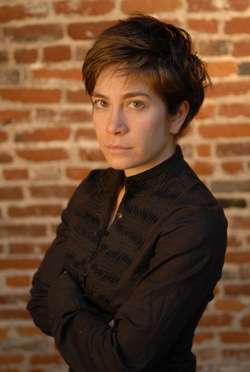

Phoenicia Pettyjohn graduated from the Los Angeles County High School for the Arts. She has been performing with peckpeck dance ensemble for four years. She has performed with many other Bay Area choreographers including: Christy Funsch, Brooke Broussard and Alma Esperanza Cunningham Dance. This is her second project with Catherine Galasso. She is also the Director of Bathroom Education for the ODC Dance Commons.
Isadora Duncan, the founder of modern dance, was born in San Francisco in 1877, three years before Emperor Norton’s death. From an early age, Isadora was drawn to create a new kind of dance, but she left San Francisco at the age of eighteen because the city proved “inhospitable” to her ideas, saying, “They just don’t understand.”
Marina Fukushima as Joaquin Murietta


Marina Fukushima, a native of Tokyo, Japan, came to the United States when she was fifteen years old to study dance under the direction of Bonnie Mathis in Minnesota. She received her BFA in Dance from Butler University in Indiana and continued her studies at the University of Iowa, where she received her MFA in Dance. She has danced with Anne Bluethenthal and Dancers, Mark Foehringer Dance Project, ODC/San Francisco, and Project Agora. She is currently a member of KUNST-STOFF. Her work has been presented at the American College Dance Festival in Boulder, Colorado, ODC Theater and Project Artaud Theater. In addition to performing and choreographing, she enjoys teaching Advanced Beginning Ballet at ODC/Dance Commons.
Joaquin Murietta, also known as the Robin Hood of El Dorado, was a legendary figure during the California Gold Rush of the 1850’s and has come to symbolize Latino resistance against Anglo-American domination. Murietta was hunted and killed at the age of 23 by ranger Harry Love, his head preserved in a jar of brandy and exhibited to spectators for the price of $1.
Christine Bonansea as Frederick Willie Coombs


Christine Bonansea studied for 3 years at the University of La Sorbonne (France) and graduated in modern dance from a French National Dance School and two major French Choreographic Dance Centers (Regine Chopinot and Mathide Monnier). For the last 10 years she has been dancing in France, Switzerland and the USA, as well as exploring contact-improvisation, acting, clown, video, and graphics. In San Francisco since 2006, she has danced with EmSpace Dance, Huckabay Mc Allister Dance, Lisa Townsend Company, PeckPeck Dance ensemble, Paige Sorvillo/blindsight, Kim Epifano, Kelly Kemp & company and Catherine Galasso, as well as performed in the video “Green” for Dance Monks and acted for Nara Denning/ Distiller film. She is currently creating her own video dance series, and is a Dance medicine Specialist – Pilates Instructor at St Francis Memorial Hospital.
Frederick Coombs, otherwise known as George Washington the 2nd, was a phrenologist by trade, as well as an accomplished photographer, daguerreotypist, and inventor. In 1860’s San Francisco, Coombs could be seen wearing a powdered wig and carrying a banner proclaiming himself "The Great Matrimonial Candidate." He left the city and returned to his native New York after Norton issued a decree to have him sent to the Lunatic Asylum.
Andrew Wass as Joshua Norton


Andrew Wass began dancing in college, replacing the chem lab with the dance studio. Since living in the Bay Area for the past 6 years, he has had the opportunity to perform in work by Scott Wells, Jess Curtis, Nina Martin, Shelley Senter, and Mary Overlie. His dance films have been shown in film festivals in LA, Minneapolis, Rio de Janeiro, Houston, Berlin, and San Francisco. His performance work has been shown in San Diego, LA, San Francisco, Marfa, Tijuana, and New York. In 2007 he received an Izzie nomination for Music/Soundscore/Text, an artist residency at Djerassi and the Jack Loftis and Vibeke Strand, MD honorary Fellowship . He has been a member of Lower Left since 2001 and co-founded Non Fiction with Kelly Dalrymple in 2007.
Joshua Norton was a pillar of the San Francisco community during the mid 1800s and a prominent member of the business elite. In 1858 Norton lost his entire fortune in an attempt to corner the rice market, and by all accounts lost his mind as well, proclaiming himself a year later “Emperor of the United States and Protector of Mexico.” The interesting part about Norton’s story is that the city played along – the newspapers published his proclamations, he issued his own currency, and for 20 years was a celebrated presence in San Francisco.
Julie Sheetz as Lillie Hitchcock Coit


Julie Sheetz fled Nevada for San Francisco in 2000 with an MS in Geography and extra credits from stage and independent film productions. Lacking serious dance training but not luck, she has been honored to work with Strong Current, EmSpace Dance, Huckabay McAllister Dance, Fellow Travelers Peformance Group, Company Mecanique, Lisa Townsend, Peck Peck Dance Ensemble, Hilary Bryan, Leyya Tawil, Chris Black, Hope Mohr, L. Martina Young, and Dianne Rugg.
Lillie Hitchcock Coit came to San Francisco in 1852. She had a special relationship with the city's firefighters, and was known as one of the most eccentric characters of North Beach, smoking cigars and wearing trousers long before it was socially acceptable for women to do so.







